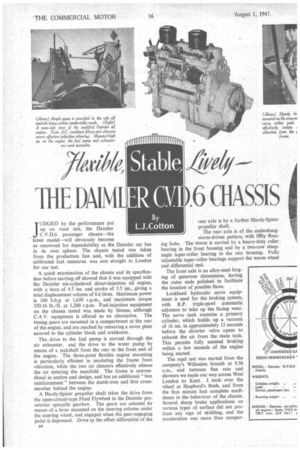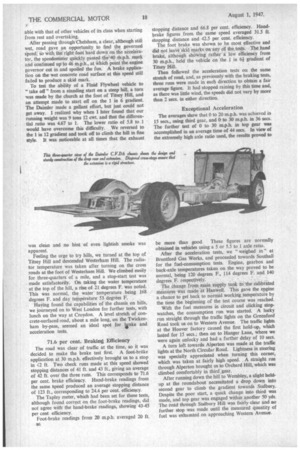THE DAIML 6 CHASSIS
Page 38

Page 40

Page 43

If you've noticed an error in this article please click here to report it so we can fix it.
JUDGED by the performance put up on road test, the Daimler C.V.D.6 passenger chassis—the latest model—will obviously become as renowned for dependability as the Daimler car has in its own sphere. The chassis tested was taken from the production line and, with the addition of calibrated fuel measures. was sent straight to London for our test.
A quick examination of the chassis and its specification before starting off showed that it was equipped with the Daimler six-cylindered direct-injection oil engine, with a bore of 4.5 ins, and stroke of 5.5 ins., giving a total displacement volume of 8.6 litres. Maximum power is 100 b.h.p. at 1,650 r.p.m., and maximum torque 350.16 lb./ft. at 1,200 r.p.m. Fuel-injection equipment on the chassis tested was made by Simms, although C.A.V. equipment is offered as an alternative. The timing gears are mounted in a compartment at the rear of the engine, and are reached by removing a cover plate secured to the cylinder block and crankcase.
The drive to the fuel pump is carried through the air exhauster, and the drive to the water pump by means of a jackshaft from the rear to the front end of the engine. The three-point flexible engine mounting is particularly efficient in insulating the frame from vibration, while the two air cleaners effectively silence the air entering the manifold. The frame is conventional in section and design, and has an additional" box reinforcement" between the dumb-iron and first crossmember behind the engine.
A Hardy-Spicer propeller shaft takes the drive from the open-circuit-type Fluid Flywheel to the Daimler pre selector epicyclic gearbox. The gears are selected by means of a lever mounted on the steering column under the steering wheel, and engaged when the gear-engaging pedal is depressed. Drive to the offset differential of the B4 rear axle is by a further Hardy-Spicer propeller shaft.
The rear axle is of the underslungworm-driven pattern, with fellly floating hubs. The worm is carried by a heavy-duty roller bearing in the front housing and by a two-row steepangle taper-roller bearing in the rear housing. Fully adjustable taper-roller bearings support the worm wheel and differential unit.
The front axle is an alloy-steel forging of generous dimensions, having the outer ends polished to facilitate the location of possible flaws.
Lockheed hydraulic servo equipment is used for the braking system, with R.P. triple-pawl automatic adjusters to take up the facing wear. The servo tank Contains a primary cylinder, which builds up a vacuum of 16 ins, in approximately 15 seconds before the diverter valve opens to exhaust the air from the main tank. This permits fully assisted braking within a few seconds of the engine being started.
The road test was started from the company;s Willesden branch at 9.30 a.m., and between fine rain and showers we made our way across West London to Kent. I took over the wheel at Shepherd's Bush, and from the first minute had complete confidence in the behaviour of the chassis. Several sharp brake applications on various types of surface did not produce any sign of skidding, and the acceleration was more than compar
able with that of other vehicles of its class when starting from rest and overtaking.
After passing through Chelsham, a clear, although still wet, road gave an opportunity to find the governed speed, so with the right foot hard down on the accelerator, the speedometer quickly passed the 4O m.p.h. mark and continued up to 46 m.p.h., at which point the engine governor cut in and spoiled the fun. A brake application on the wet concrete road surface at this speed still failed to produce a skid mark.
To test the ability of a Fluid Flywheel vehicle to "take off" from a standing start on a steep hill, a turn was made by the church at the foot of Titsey Hill, and an attempt made to start off on the 1 in 6 gradient. The Daimler made a gallant effort, but just could not get away. I realized why when I later found that our running weight was 9 tons 12 cwt. and that the differential ratio was 4.67 to 1. The lower ratio of 5.8 to 1 would have overcome this difficulty. We reversed to the 1 in 12 gradient and took off to climb the hill in fine style. It was noticeable at all times that the exhaust was clean and no hint of even lightish smoke was apparent.
Feeling the urge to try hills, we turned at the top of Titsey Hill and descended Westerharn Hill. The radiator temperature was taken after turning on the cross roads at the foot of Westerham Hill. We climbed easily for three-quarters of a mile, and a stop-start test was made satisfactorily. On taking the water temperature at the top of the hill, a rise of 21 degrees F. was noted. This was normal, the water temperature being 168 degrees F. and day temperature 53 degrees F.
Having found the capabilities of the chassis on hills, we journeyed on to West London for further tests, with lunch on the way at Croydon. A level stretch of concrete-surfaced road, about a mile long, on the Twickenham by-pass, seemed an ideal spot for wake and acceleration tests.
71.6 per cent. Braking Efficiency The road was clear of traffic at the time, so it was decided to make the brake test first. A foot-brake application at 30 m.p.h. effectively brought us to a stop in 42 ft. Two check runs made at this speed showed stopping distances of 41 ft. and 43 ft., giving an average of 42 ft. over the three runs. This corresponds to 71.6 per cent, brake efficiency. Hand-brake readings from the same speed produced an average stopping distance of 123 ft., corresponding to 24.4 per cent. efficiency.
The Tapley meter, which had been set for these tests, although found correct on the foot-brake readings, did not agree with the hand-brake readings, showing 43-45 per cent efficiency.
Foot-brake readings from 20 m.p.h. averaged 20 ft. nG stopping distance and 66.8 per cent. efficiency. Handbrake figures from the same speed averaged 31.5 ft. stopping distance and 42.5 per cent. efficiency.
The foot brake was shown to be most effective and did not leave skid marks on any of the tests. The hand brake, although sin:ming rather a low efficiency from 30 m.p.h., held the vehicle on the 1 in 61 gradient of Titsey Hill.
Then followed the acceleration tests on the same stretch of road, and, as previously with the braking tests, three runs were made in each direction to obtain a fair average figure. It had stopped raining by this time and, as there was little wind, the speeds did not vary by more than 2 secs, in either direction.
Exceptional Acceleration The averages show that 0 to 20 m.p.h. was achieved in 15 secs., using third gear, and 0 to 30 m.p.h. in 36 secs. The further test of 0 to 30 m.p.h. in top gear was accomplished in an average time of 44 secs. In view of the extremely high axle ratio used, the results proved to
be more than good. These figures are normally obtained in vehicles using a 5 or 5.5 to 1 axle ratio.
After the acceleration tests, we " weighed in " at Brentford Gas Works, and proceeded towards Southall for the fuel-consumption tests. Engine, gearbox and back-axle temperatures taken on the way proved to be normal, being 120 degrees F., 114 degrees F. and 140 degrees F. respectively.
The change from main supply tank to the calibrated measures was made at Hanwell. This gave the engine a chance to get back to normal working temperature by the time the beginning of the test course was reached.
With the fuel measures in circuit and clicking stopwatches, the consumption run was started. A lucky run straight through the traffic lights on the Greenford Road took us on to Western Avenue. The traffic lights at the Hoover factory caused the first hold-up, which lasted for 15 secs.; then on to Hanger Lane, where we were again unlucky and had a further delay of 10 secs.
A turn left towards Alperton was made at the traffic lights at the North Circular Road. Lightness in steering was specially appreciated when .turning this corner, which was taken at fairly high speed. . A straight run through Alperton brought us to Orchard Hill, which was climbed comfortably in third gear.
After running down the hill to Wembley, a slight holdup at the roundabout necessitated a drop down into second gear to climb the gradient towards Sudbury. Despite the poor start, a quick change into third was made, and top gear was engaged within another 50 yds. The road through Sudbury Hill was fairly clear and no further stop was made until the measured quantity of fuel was exhausted on approaching Western Avenue.
Over a distance of 8.7 miles, 5.14 pints of fuel had been used, the consumption rate equalling 13.54 m.p.g The time taken to cover the distance was 19.5 mins., and the average speed was 26.8 m.p.h. This average reflects the top-gear flexibility of the engine, especially as 33 m.p.h. was the maximum speed throughout the course.
Although the rear-axle ratio of 4.67 to 1 would be mainly used in a coach, the performance on the first test gave good grounds for making a second run on the same route, with stops representative of stage-service conditions.
Returning to the starting point, the measures were refilled and the second run was started. This test was made over the same course, with 15-sec. stops every quarter of a mile. There was much more traffic on the road during this run, but with exactly timed stops, coupled with good driving, th. test was carried out strictly to schedule.
On this second test the fuel was expended at the top of Orchard Hill, 5.5 miles from the starting point, and the consumption rate was 8.56 m.p.g. The time taken was 22,5 mins. and the average speed 14.7 m.p.h.
After a change back to the main fuel supply systene the return run to Willesden was made The total distance of 120 miles covered during the day was sufficient to reveal any weakness that might occur in the operation of the vehicle, and to enable its good features to be appreciated, I drove the chassis for the major part of the day and found it comfortable to handle—all controls being light and within easy reach—lively on acceleration and well behaved when braking under all conditions of road surface.












































































